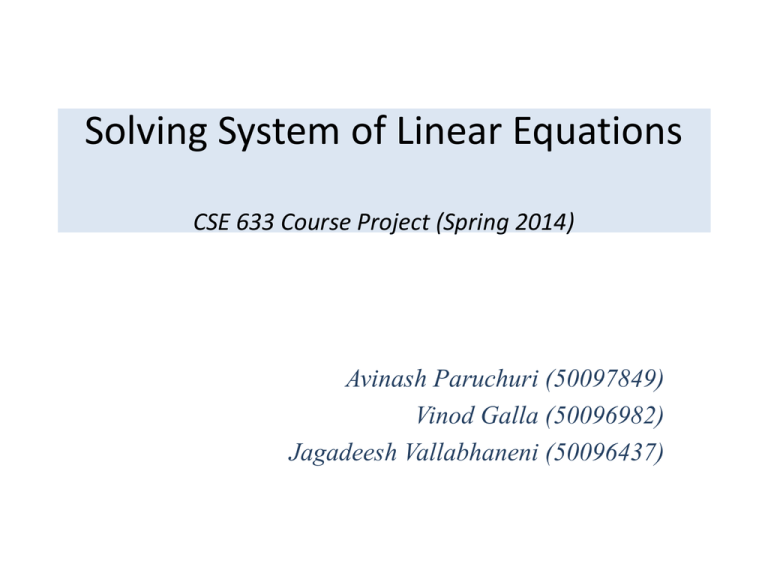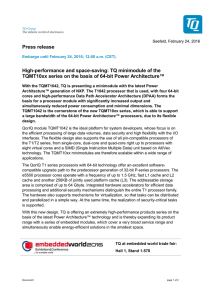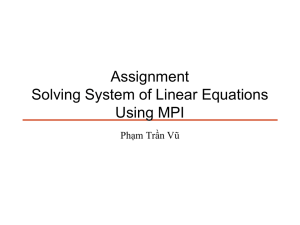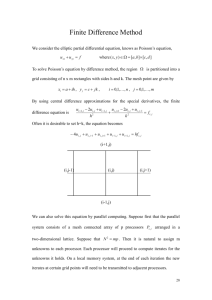Solving System of Linear Equations CSE 633 Course Project (Spring 2014)
advertisement

Solving System of Linear Equations
CSE 633 Course Project (Spring 2014)
Avinash Paruchuri (50097849)
Vinod Galla (50096982)
Jagadeesh Vallabhaneni (50096437)
Equation Form
Ax = b
where A ∈ Rn×n is an n × n matrix of real numbers, b ∈ Rn is a vector of
size n, and x ∈ Rn is an unknown solution vector of size n.
Solution exists only when there exists a matrix A-1 such that A · A−1 = I
Methods of Implementation
• Direct Method – Gaussian Elimination
Exact solution except rounding errors
• Iterative Method – Jacobi Method
Determination of an approximate solution
than exact one
Gaussian Elimination
Gaussian Elimination
• Forward Elimination and Backward
Substitution
• Upper Triangular form
Parallel Implementation Details
•
Block distribution
–
–
•
Processor with rank 0 scatters data
n rows, p processors – each processor has n/p rows
Forward elimination
–
For first processor,
For first row
•
•
Make pivot element 1 by doing row operations
For lower ranked rows in the same processor, make the corresponding elements 0 by row operations
Do this for other rows one by one
– Send the data to other processors ranked higher
Do this for other processors (from low to high) one by one
•
Backward substitution
–
–
The matrix is now in upper triangular form (i.e all the elements before pivot element in each row are zero
and pivot element is 1)
From last to first processor,
For last to first row
•
For higher ranked rows in same processor, make the elements in the same column 0 by doing row operations
Do this for other rows from bottom to top
– Send the data to other processors ranked lower
Do this for other processors (from high to low) one by one
•
Processor with rank 0 gathers the data from all other processors which is the output vector
Parallel Implementation using Example
=
Ax = b
Demonstrated in class
Jacobi Method
Jacobi Method
Calculating X
Distribution at each Process
Algorithm
Choose an initial Xnew = b.
int iteration = 0;
int k = num of rows per process;
do {
Xold = Xnew;
for i=1…k, do
σ = 0;
for j=1…n, do
if (i != j), then
σ = σ + aijxjold;
end-if.
end-for.
xinew = (bi – σ)/aii;
end-for.
MPI_Allgather(Xnew);
iteration++;
} while((!converged) && (iteration < MAX_ITERATIONS));
Input
• A = Diagonally dominant square matrix
MPI Functions Used
Results – Gaussian Elimination
Time vs Number of processors (Data Size 2048)
#processers
time taken
1
7.24
2
3.37
4
1.88
8
0.97
16
0.53
32
0.32
64
0.19
128
0.18
256
0.22
8
1, 7.24
7
6
Time
5
4
2, 3.37
3
2
4, 1.88
1
8, 0.97
16, 0.53
32, 0.32
0
0
50
64, 0.19
256, 0.22
128, 0.18
100
150
Number of processors
200
250
300
Results – Gaussian Elimination
Time vs Number of Processors
900
800
700
600
Time
500
Data Size : 4096
400
Data Size : 8192
300
200
100
0
0
50
100
150
Number of Processors
200
250
300
Results – Gaussian Elimination
Time vs Data Size (256 Processors)
140
120
Data size
(Number of
Row)
Time Taken
2048
0.22
4096
0.73
8192
3.76
16384
52.53
32768
120.6
100
Time
80
60
40
20
0
0
5000
10000
15000
20000
Data Size
25000
30000
35000
Results – Jacobi Method
Time vs Number of Processors (Data Size 8192 Rows)
7
6
1, 5.91
5
Number of
Processors
Time
1
5.91
2
3.66
4
2.12
8
1.47
16
1.07
32
0.98
64
0.81
128
0.68
256
0.71
4
Time
2, 3.66
3
4, 2.12
2
8, 1.47
16, 1.07
32, 0.98
1
64, 0.81
256, 0.71
128, 0.68
0
0
50
100
150
Number of processors
200
250
300
Results – Jacobi Method
Time vs Number of Processors
18
16
14
12
Time
10
Data Size : 8192
8
Data Size : 16384
6
4
2
0
0
50
100
150
Number of Processors
200
250
300
Results – Jacobi Method
Time vs Data Size (Number of Processors 256)
18
Data Size
Time
2048
0.08
4096
0.21
8192
0.71
16384
2.7
32768
16.83
16
14
Time
12
10
8
6
4
2
0
0
5000
10000
15000
20000
Data Size
25000
30000
35000
Results – Gaussian vs. Jacobi
Gaussian vs Jacobi (Number of Processors 256)
Data Size
Jacobi
Gaussian
2048
0.08
0.23
4096
0.21
0.65
8192
0.71
3
16384
2.7
40.18
32768
16.83
100.4
120
100
Time
80
60
jacobi
gaussian
40
20
0
0
5000
10000
15000
20000
25000
30000
35000
Data Size
Comparison between both methods for diagonally dominant data
Future Work
• Using Relaxation methods for Jacobi Method
• Gauss – Seidel for large sparse matrices
• Use cyclic distribution in Gaussian Elimination
References
• Parallel Programming for Multicore and Cluster Systems (Thomas Rauber
and Gudula Runger)
• Iterative Methods for Sparse Linear Systems, Second Edition (Yousef Saad)
• Message Passing Interface (MPI) forum http://www.mpi-forum.org
• MPI Tutorial http://mpitutorial.com/
Thank You




